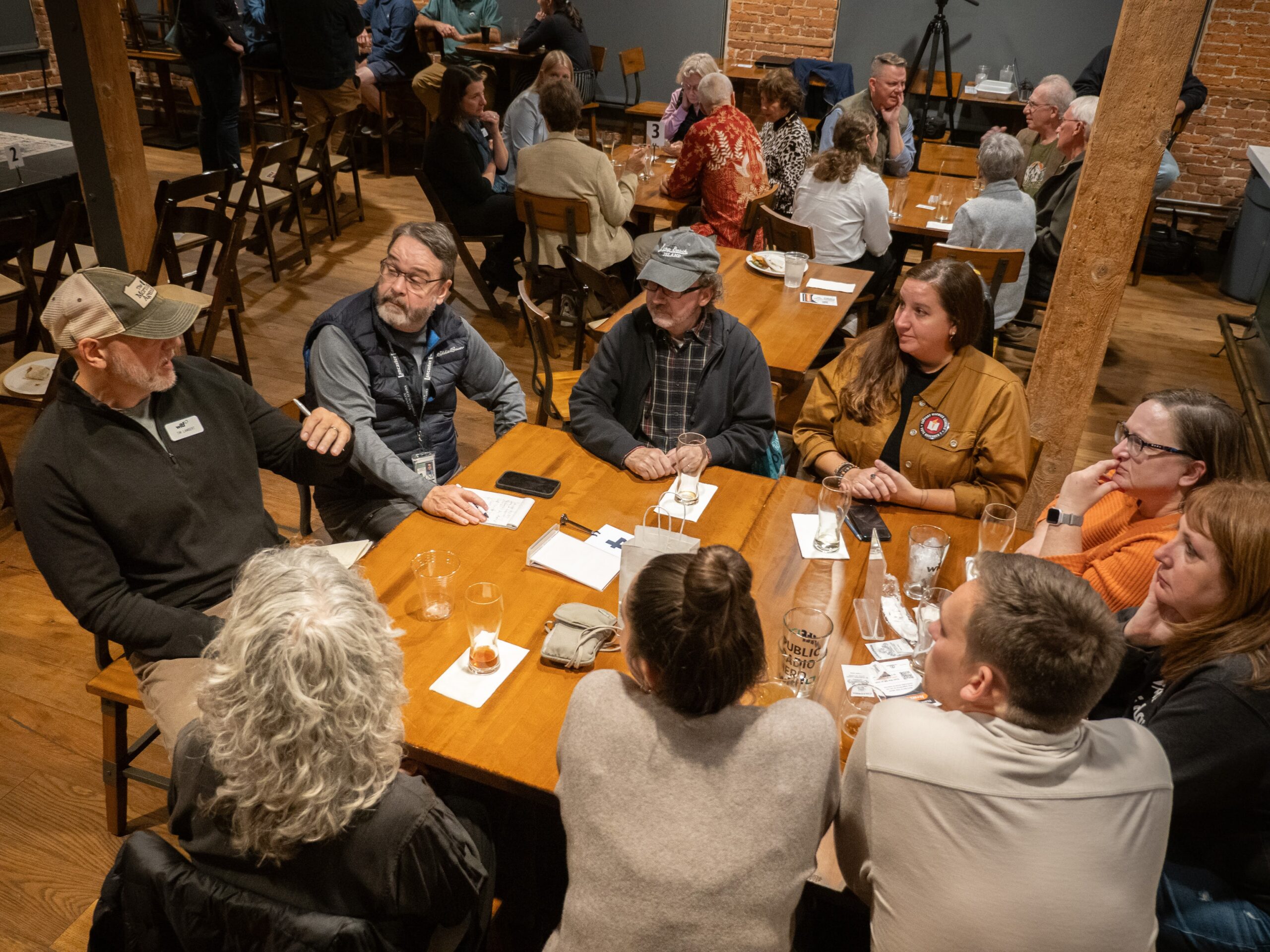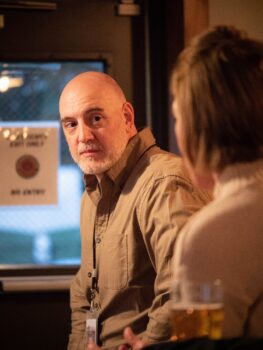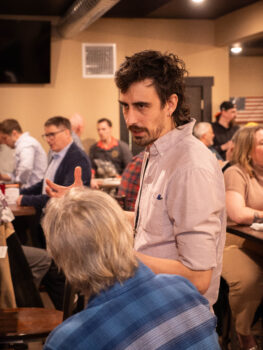How WITF is using democracy reporting to build trust and tamp down political rhetoric
Tim Lambert, WITF,
Tim Lambert (left), WITF's special projects editor, speaks during a small-group discussion at a News and Brews event at Sign of the Horse Brewery in Red Lion, Pa., in March 2024. WITF uses these events to learn what issues are important to community members. (Photo by Tom Downing/WITF)
Here’s an idea to steal and adapt: Instead of focusing on negative horse-race campaign coverage, offer the audience possible solutions and paths forward with democracy reporting.This is a series on Better News to a) showcase innovative/experimental ideas that emerge from the Knight-Lenfest Newsroom Initiative and b) share replicable tactics that benefit the news industry as a whole.
This “win” comes from Tim Lambert, special projects editor at WITF in Harrisburg, Pa. WITF participated in the Poynter Table Stakes Program in 2018-19.
More ideas from Better News on rethinking your election coverage:
Question: What problem were you trying to solve, and why was that problem strategically important to your organization?
A: When a 20-year-old tried to assassinate former President Donald Trump in Western Pennsylvania on July 13, 2024, questions were raised about the man’s political beliefs. Some Republicans began to falsely link the shooting to Democrats or wild conspiracy theories. The potential for retaliatory violence or unrest seemed realistic.
Since WITF is based in the key battleground state of Pennsylvania, it was important to us to try to find a way to offer our audience an outside-the-box story and not follow the typical script in the wake of a major political event.
Because the assassination attempt occurred outside our coverage area, we had a little more space to bring something different to the table. For more than four years, our newsroom has been focused on issues surrounding democracy, avoiding “horse race coverage” of politics, and zeroing in on community engagement with voters.
We are one of the few media organizations in the state with a Democracy beat, so it was important for us to find an angle that brings a solution of sorts to people that they can take into conversations in their communities.
Q: How did you go about solving the problem?
A: It’s important to rewind four years to the most challenging year I have ever dealt with in more than 30 years as a journalist. You had the COVID-19 pandemic, social justice protests and unrest. You also had a former president’s months-long attempt to discredit election results, with ensuing attempts to overturn the vote, and the culmination of the violent Jan. 6, 2021, attack on the U.S. Capitol.
We were caught unawares about the ability of “bad faith” actors to spread misinformation and disinformation with a significant impact on audiences. We missed the underlying threats of political violence.
So when the Jan. 6 attack happened, our newsroom leadership was shocked into realizing that our work to stand up for facts and counter misinfo/disinfo wasn’t enough. We had to find ways to improve our coverage of issues surrounding the democratic process and hold accountable the lawmakers who contributed to the 2020 election lie.
The biggest step we took was to establish an election accountability policy based on facts. That led us to establish a Democracy beat to provide factual information to listeners/readers/viewers about how elections work, detail how misinformation spreads, and monitor extremist groups.
We became one of the few media organizations in Pennsylvania to devote resources toward this kind of topic. Those two decisions led us to re-evaluate and eventually change how we approached election coverage and move away from “horse rae coverage, reporting on polls, and treating campaign events as, “candidate X says….” We decided to focus on voters.
We didn’t want to know who people are voting for in an election, but what issues matter to them. Democracy SOS provided the road map, as well as connections to like-minded journalists across the country. We also strengthened our affiliation with America Amplified, an initiative to help public media journalists develop the skills to put listeners at the center of their reporting process, to help us center community engagement as a driver of our coverage.

Tim Lambert, special projects editor at WITF, Pa., listens during a News and Brews event at Gearhouse Brewing Co. in Chambersburg, Pa., in 2022. (Photo by Tom Downing/WITF)
We revamped our News and Brews events at bars throughout our coverage area to focus less on HOW we do journalism and more on LISTENING to community members. With the focus on listening, we used a grant from America Amplified to purchase a mobile listening lab. Essentially, it allows us to bring together a handful of people from a particular community and record the conversation about what issues matter to them. We air them with minimal narration from our reporters. The focus is on their voices.
An approach we have also started to explore takes a lot more time, effort and money. Deliberative forums bring together a demographically representative group, provide them with in-depth background material on the subject matter of the forum, and create questions to engage attendees in small-group discussions designed to produce ideas and potential solutions. We have partnered with Franklin & Marshall College in Lancaster, Pa., on the effort, which also included an event on democracy.
Many of these strategies depend on hearing from a diverse group of voices. In the 2024 election cycle, we have made an effort to reach out to right-leaning listeners, who may not like or trust public media. WITF is located in a conservative part of Pennsylvania, so if we aren’t hearing from them, we are missing a piece of the coverage area’s mosaic. It has been slow, steady work. Often, it’s on a person-to-person basis. But, we have had some success.
Q: What worked?
A: A lot of it did. In email and in-person conversations with listeners, we have heard how they appreciate the shift away from poll stories and typical campaign events. We started holding listening sessions with certain groups to discuss issues that matter to them and airing them without much narration from our reporters.

Jordan Wilkie, WITF’s democracy reporter, participates in a small-group discussion during a News andBrews event at Sign of the Horse Brewery in Red Lion, Pa., in March 2024. (Photo by Tom Downing/WITF)
At rallies, we ask voters about what’s important, instead of just airing canned soundbites from candidates that don’t say anything. We delve into why people in Central Pennsylvania are concerned about the southern border and how they think it impacts their community.
We hear how people feel about the lack of drop boxes for mail-in ballots. Thanks to events like our News and Brews, we have compiled a list of issues identified by people in the communities we visit. We talk to people with different perspectives.
Most importantly, our Democracy reporter, Jordan Wilkie, has focused on producing stories about the election process as a way to pre-bunk any potential conspiracy theories. He has forged partnerships with other news organizations, like Votebeat Pennsylvania, that allow us to avoid duplicating efforts on certain topics, thus saving resources.
Since Jordan joined us over the winter, the April primary in Pennsylvania was an opportunity for him to get up to speed on how the state conducts elections. He wrote about how smoothly the voting went, detailed what needed to be done before results become official, and explained the issue over a delay in certification in one county.
Q: What didn’t work?
A: As with any news organization, the lack of resources has limited the number of stories we’ve been able to flesh out. Our newsroom is down three reporters since the 2020 election, when we had six.
So, the needs of producing copy to fill newscasts have been pulling our team away from some of the big-picture election coverage. The number of community listening sessions we had hoped to conduct is smaller at this point than we had hoped.
As you can imagine, the number of stories Jordan could cover range from extremist groups to lawmakers spreading misleading information to every twist and turn in the election process. So, it’s important for editors to keep the beat as focused as possible.
Q: What happened that you didn’t expect?
A: This brings us back to how we decided to cover the assassination attempt this past July against former President Donald Trump.
It happened in our state, but outside our coverage area in Western Pennsylvania. Jordan was locked in on finding a way to provide something useful to listeners. We were getting the breaking news angles from our longtime partner, WESA in Pittsburgh, which allowed us to take a breath.
Jordan came up with the idea to talk to experts about peace-building in a very divisive time. The result was both a digital and audio story that gave our listeners a way to make a difference, tamp down the heated rhetoric and keep the lines of communication open between people with differing political views.
Ten years ago, a topic like this would have never crossed my mind. Now, it seemed like the perfect approach, simply because of how our mindset has evolved. Did it resonate with listeners? It’s hard to say, because changes in social media algorithms have severely downplayed news stories and interaction on sites like Facebook, Twitter (now known as X) and Instagram.
Q: What advice would you give to others who try to do this?
A: Be ready to embrace change. Be ready to stand by the work. Be ready for “bad faith” criticism that you are showing bias or choosing sides.
But, do it. News organizations have been facing a constantly shifting landscape for years and years and people have more options than ever to find news. We also can’t ignore how trust in legacy news organizations keeps dropping, while local news keeps shrinking and shrinking.
This is a way to rebuild trust, and reconnect with your audience on a personal level. Remind them that no national outlet knows the community better than you.
Shift the majority of your coverage away from what issues a candidate says are important to a model that allows voters to detail what issues matter to them. You will be reminding voters about civics lessons they learned in school (or if you are of a certain vintage, with cartoons about being a bill on Capitol Hill. But, I digress).
You will chip away at the trend where national issues become local issues, simply because there is no local media to highlight what matters to different communities.
Q: What’s next for this work?
A: Get through the November election. The end.
Seriously, Jordan’s already revisited his peace-building theme with a story about reaction to a group of neo-Nazis who recently marched in Harrisburg, with a bit of accountability reporting.
He is in the process of working on more than a dozen basic stories on the election process that we will also produce as videos to reach as many people as possible.
As for our newsroom, I think we are just scratching the surface of where we want to go with this approach. It’s been more than a year since WITF was gifted LNP | Lancaster Online — a news organization focused on covering a single county in Central Pennsylvania.
As we move to integrate our newsrooms, I’m excited to have conversations with my fellow editors at LNP about the possibilities of utilizing some of these approaches in their coverage plans.